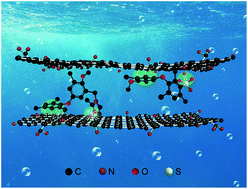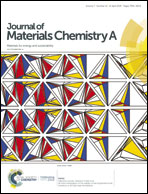Non-covalent cross-linking to boost the stability and permeability of graphene-oxide-based membranes†
Abstract
Two dimensional (2D) membranes assembled from graphene oxide (GO) nanosheets are easily delaminated in water within few hours, posing a critical challenge for water purification applications. Herein, we propose to modify GO membranes' stability by intercalating ionic polymers rich in benzene and cationic imidazolium (or anionic sulfonic acid) moieties, which are able to cross-link neighbouring GO nanosheets via non-covalent interactions. The 2D C-GO (imidazolium intercalation) and A-GO membranes (sulfonic acid intercalation) in the solvated state can even maintain their regularity for long periods, while the solvated GO membrane immediately decomposes into nanosheets once soaked in water. For nanofiltration applications, the solvated C-GO and A-GO membranes show extraordinarily higher permeances of 1111 and 600 L m−2 h−1 respectively under 5 bar, in contrast to the original GO membrane with a moderate permeance of 65 L m−2 h−1. For desalination, C-GO presents prominent advantages of a higher water flux of 2.49 L m−2 h−1 and rejection of 95% to NaCl over GO with a water flux of 1.66 L m−2 h−1 and a rejection of 76%. The non-covalent cross-linking paves a way to get access to highly stable and efficient transport lamellar membranes.



 Please wait while we load your content...
Please wait while we load your content...